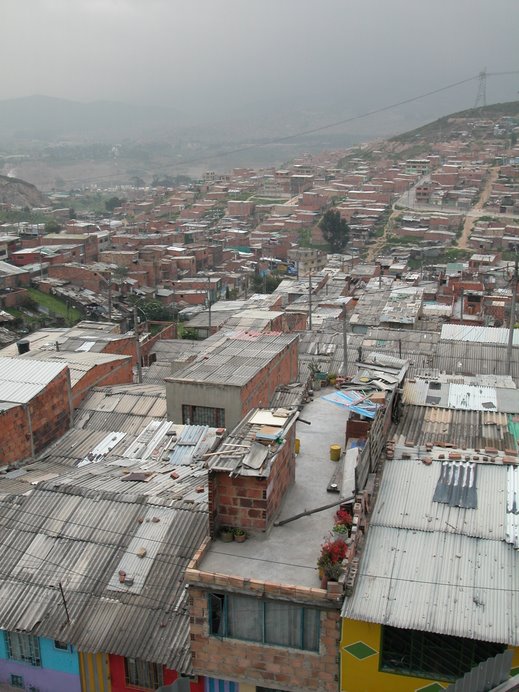 |
| During the festival a band played to a crowd seated in front of the church. |
I attended the La Perseverancia neighborhood's annual Chicha Festival this year, only to be isappointed - there was no chicha for sale. An acquaintance met there explained that the chicha had been sold out to a record crowd on Saturday. That's no too surprising, since the last several weeks have been quite warm, with a blazing sun. I suppose that that's a vote in favor of the festival organizers' decision to move the festival from its historical October date, when it often rained.

 |
| A dancer spins during the chicha festival. |
La Perseverancia is a traditional blue-collar neighborhood on the lower reaches of Bogotá's Easter Hills, between La Macarena and the National Park. Originally built by and for the workers of the Bavaria Beer Brewery with the support of the company's far-sighted owner Leo Kopp, it has become known instead for brewing of chicha, a traditional drink made from fermented corn.
 |
Serving chicha from a plastic bottle.
This was about the only chicha I saw today. |
The neighborhood, known affectionately as 'La Perse', grew up in the first decades of the 1900s, when families migrated from the Egipto and Belen neighborhoods to work in the Bavaria Brewery, located down the hill across Ave. Septima from what was then a prison and is now the National Museum. The old Bavaria brewery, with its recognizably German arquitecture, today contains shops and offices. The company, which continues to dominate Colombian beer-making, has a newer brewery in western Bogotá.
 |
| A street fills up - but not with chicha drinkers. |
Bavaria owner Kopp, a Jewish-German immigrant, helped his workers pay for their homes and assisted them in bringing water, electricity and sewerage services to the neighborhood. Many families also built adobe homes with their own hands and sweat. In the spirit of a blue-collar community, the church was named after Christ the Laborer and the plaza featured a 'Monument to Work', which has apparently disappeared.
The neighborhood became a stronghold of support for fiery leftist politician Jorge Eliecer Gaitan, who was assassinated in the city center in 1948. Today, there's a small statue to the martyred leader, his right arm as always raised up toward the sky.
 |
A crowd in front of the
Church of Christ Laborer. |
The chicha festival, which began in 1988, honors a drink which has survived in a hostile world. For decades in the early 1900s the beer and liquor industries and the government propagandized against chicha, claiming that it caused diseases and turned drinkers insane. The anti-chicha lobby's real motives were economic - to sell more of competing alcoholic drinks. The government also wanted to turn the public away from homemade chicha, which didn't pay taxes, to other drinks, which did.
But chicha has survived, and continues holding an important place in the stomachs and minds of many B
ogotanos.
Chicha's survival also happens to be an illustration of another thing - the futility of trying to prohibit mind-altering substances.














































